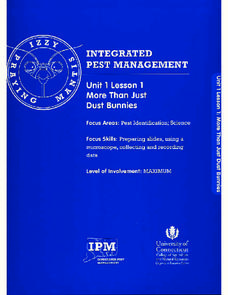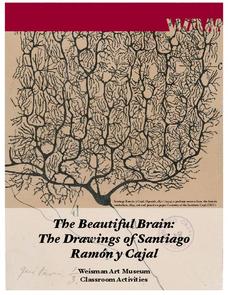Curated OER
Through Other Eyes
High schoolers describe the structures of crustaceans and the features that give organisms capabilities that exceed those of humans. In this investigative lesson plan students replicate some of the features of photo-receptors in a...
Curated OER
IDENTIFYING PARTS OF THE BODY
Learners identify and describe the various parts of the body therefore, practicing English vocabulary, pronunciation, and spelling. They discuss the various body parts, some of the inner organs and also, their functions. Finally,...
Curated OER
Feelin' Buggy
Students discuss five senses, compare and contrast human and insect senses, use adjectives to describe things they touch, smell, and see, and write stories in first person describing what it would be like to be size of insect.
University of Minnesota
Beautiful Brain: Do You See What I See?
Can art play tricks on your eyes, and can a still painting really appear to vibrate? The second lesson in a four-part series discusses the way our beautiful brains translate visual images. It highlights the style of optical art and...
American Museum of Natural History
Trip Up Your Brain
Sometimes different parts of the brain disagree. See what this disagreement looks like using a remote learning resource to experience how brains often take shortcuts. Pupils complete the activity, observe their results, and then read...
eSkeletons
Skeleton Scramble Puzzle: Suborder Prosimians
Explore the finer details of primate skulls with these puzzles, incorporating advanced scientific analysis of two suborders- Prosimians and Anthropoidea- and one superfamily- Hominoidea. Learners read about the unique characteristics of...
Curated OER
Volcanoes: Windows Into The Earth
Students investigate the concepts related to volcanoes and focus upon Mt. St. Helens. They define the difference between an active and dormant volcano. They conduct research using a variety of resources. The information is used in order...
University of Connecticut
More Than Just Dust Bunnies
Teenagers will never complain about cleaning their rooms after this activity. In the first lesson of a four-part series, budding scientists collect samples of dust, chalk, and other particulates from various areas of the classroom. They...
Curated OER
Reproduction and Development
Have a sense of humor when discussing human anatomy with your class! Through puzzles and riddles, learners become comfortable with words relating to reproduction and development. They combine mixed up words from the "vocabulary gene...
University of Minnesota
Beautiful Brain: Strangest Dream
Do words change or add meaning or interest to a work of art? The final lesson in a four-part series on the beautiful brain as a work of art focuses on art analysis. Scholars write a story about exploring art from the inside. Reflections...
Beyond Benign
The Big Melt: Arctic Ice Caps
Are the Arctic ice caps really melting out of existence? Junior climatologists examine the statistics of ice decline through four math-based lessons. Each activity incorporates data, climate information, and environmental impact into an...
American Museum of Natural History
What's This? Gold
Cell phones are likely made of gold—at least part of them! An interesting lesson explains the conventional and not-so-conventional uses of the popular element gold. From the Inca empire to modern-day technology, learners discover gold...
Curated OER
Label the Picture - Your Body
In this body part worksheet, students practice their printing by labeling each body part pictured. Students use words from the word box to help them label.
Curated OER
Body Outlines
Students trace their bodies onto butcherblock paper and then add clothes, hair, eyes, mouths, etc. They use them to identify their body parts.
Curated OER
Catch a Wave. . .
Part of a larger online space science website, this page has a brief explanation of electromagnetic radiation and a chart of wavelengths as compared to common objects. There are four questions to answer about the information. This can be...
Curated OER
Skeletal System And External Body Development Of A Full Term Fetus
Students explore the skeletal system and external body development of a full term fetus. In this biology lesson plan, students learn that growth of a full-term fetus' skeletal system and external body parts become more detailed and...
Curated OER
Levers in the Body: They Are Not What You Might Think!
Learners investigate lever systems in the human body and compare arm anatomy to model. In this human levers lesson plan students graph and analyze their results.
Curated OER
Soybean Science
Fourth graders explore food science by participating in a cooking activity. In this soybean oil instructional activity, 4th graders listen as the teacher gives them a background on soybeans and their use by humans today. Students grind...
Curated OER
Reflection of Light and Mirrors
Students address common misconceptions concerning reflection, light and mirrors. They investigate light reflection in mirrors and determine how light is transferred to the eye. In addition, they make predictions and then test them...
Curated OER
Making Cents of the Senses
Students explore sight and hearing. In this senses lesson, students read Brown Bear Brown Bear, discuss how eyes are used for sight, and chart the eye color of the students in the class. Students discuss how hearing is important, take a...
Curated OER
Snow Goggles
Students assemble snow goggle models and discuss how snow goggles change the amount of light shining in their eyes.
Curated OER
Pond Habitats
Young scholars define what a pond habitat is and explain what animals live in this habitat. They discuss what can harm or destroy a pond habitat. They create a poster of what could harm a pond habitat including illustrations and...
Curated OER
My Five Senses
Students investigate the five senses. For this senses lesson, students explore the nervous system. Students examine how the body receives information through the five senses.
Curated OER
Body Exercises: Galaxy 3
In this animal body parts instructional activity, learners label the animals, complete sentences, complete a word search, and more. Students complete 4 activities.

























